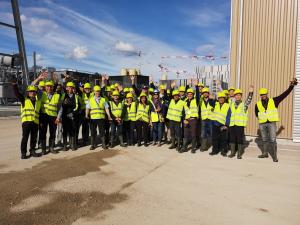Integrated team holds 100th meeting
ITER Director-General, Bernard Bigot, opened the 100th BIPT meeting with introductory remarks, tracing the history of the BIPT and highlighting the major accomplishments from pre-conceptual design in 2008 to the signatures of seven Procurement Arrangements, and now series production. The next goal is to have the components manufactured and delivered according to specification and on time.
Following the introduction, the meeting proceeded as most of the previous 99 BIPT meetings had. Different groups reported progress in several areas—including production and storage, integration techniques, validation procedures, and design reviews for diagnostic components.
A complex system requires close coordination
The blanket is a particularly complex system—even by ITER standards. It covers a plasma-facing surface area of 610 m², and consists of 440 individual blanket modules. Each module has a relatively thin first wall panel in the front, mounted on a relatively thick shield block at the back. The front part of the module faces the ultra-hot plasma; the back part has features that allow it to be attached to the vacuum vessel.
Blanket modules must accommodate high plasma heat fluxes (up to 4.7 MW/m²) and particle fluxes on the first wall as well as powerful electromagnetic forces. At the same time, they must provide essential neutron shielding to protect the components at the back—in particular, the vacuum vessel and the cryogenically cooled superconducting magnets, which operate at around 4 Kelvin (-269 °C). On top of all that, the blanket modules must accommodate the space allocations for in-vessel coils, manifolds, plasma heating systems and diagnostics.
The ITER blanket will be the first actively cooled blanket operating in a fusion environment. Blankets will be an essential feature of all tokamak-style fusion reactors, providing a giant barrier to stop most of the neutrons generated by the fusion reaction. In the process, blankets convert energy from the neutrons into heat and shield the superconducting magnets and vacuum vessel from the neutrons. Blankets in commercial reactors will have additional features that generate tritium to serve as fuel for the reaction. Neutrons smashing into lithium-containing areas of these future blankets will result in small nuclear reactions that produce tritium fuel, and heat that is channeled for use in the reactor.
To avoid adding another layer of complexity, the ITER blanket has not been designed to produce tritium fuel—instead the installation will rely on purchased tritium. However, ITER does have a test blanket module program, which will test mockups of tritium-breeding blankets installed in equatorial ports.
The BIPT stands out as a successful example of an Integrated Product Team
Having different organizations work independently to produce complex components that fit together to make a working system is a risky proposition—especially when the system is first-of-a-kind. To head off the potential hazards, the ITER Council decided in November 2008 to create Integrated Product Teams (IPT) to combine the resources and capabilities of ITER Organization and the Domestic Agencies and channel them to work as a single team with a sense of shared design ownership.
The Blanket IPT was one of three inter-organizational teams created at that time for similar reasons and it is the only IPT still in operation. With a long list of accomplishments that attest to the success of the team over more than a decade, René Raffray is looking to the future.
"The BIPT success is based on a lot of work," says Raffray. "We have been fortunate to have had well over 200 people contributing to the BIPT over the years. We have encouraged open discussion at meetings, developed a sense of trust and teamwork, and held some positive team-building activities outside the meetings. It was important for the whole team to have a say in the design and to feel a sense of ownership. This has worked—and now we have brought the blanket system all the way to procurement."
"We will continue to run the team in as collaborative a manner has possible," continues Raffray. "We still need open discussion on ongoing procurement activities, especially when several Domestic Agencies procure the same components. We need to make sure issues are solved in a transparent way, and that all parties feel they are being heard."
"We have a strong foundation on which to continue building. But the usefulness and success of the BIPT in the future will really depend on the ongoing contribution of each team member from the Domestic Agencies and the ITER Organization, and on how they make the most of this platform to progress on procurement of the different blanket components."
After all, this 100th meeting is far from the last. Bernard Bigot ended his introductory speech by offering his steady support to the ongoing BIPT effort as it works towards Pre-Fusion Power Operation 1 in 2028 or 2029.



